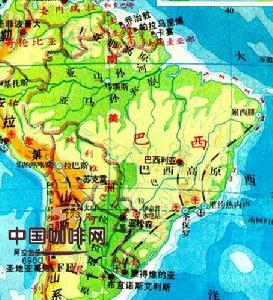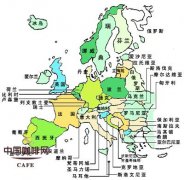Coffee in South America
[Colombia]
It is the second largest coffee producer in the world, accounting for about 12% of the world's annual output, which is much lower than that of Brazil, which is 30 to 35%, but most of them are high-quality mountain-washed beans. Central Colombia is divided into valleys by three north-south longitudinal mountains, of which the central and eastern mountains are the main coffee producing areas. The coffee here is named after a distributed market, with Medellin, Armenia and Manizales in the Central Mountains and Bogota and Bucaramanga in the eastern mountains.

The most famous Medellin in the Central Mountains has a thick texture, rich aroma and well-balanced sour taste, while Armania and Manizares are not so good, but in the market these three kinds of beans will be regarded as the same kind of beans to circulate, called "MAM". If you buy a bag of MAM, it may be any of these three kinds of beans, it has a texture and flavor similar to Medellin, but not so sour, while Bukala has a bit of Sumatran characteristics, thick texture, rich taste and weak sour taste. According to the size of the particles, the highest Columbia beans are "Supremo" and the second are called "Extra", but in the market these two levels are often referred to as the same grade, called Excelso.
The best Colombian beans, similar to Costa rica or Hawaiian Cona beans, are non-extreme coffee, rich in texture, but not as strong as Sumatra; rich in aroma, but not as good as the best Jamaican alpine flavor; sour, but not as sour as Antigua acid. It often has a caramel-like taste, similar to the aroma of pudding, lack of sour fruit, reminiscent of milk pancakes; it is also suitable for blending mixed coffee. Since the 1970s, with the full promotion of the Colombian government, many old trees have been replaced by new species with high yields, but critics believe that the new coffee is milder and more common than the old ones, and its quality is much lower than it used to be. | |
[Venezuela (Venezuela) pull]
Venezuela's coffee production is not high, most of it for domestic consumption. Although Venezuelan coffee is mainly produced in the west near Colombia, its sour taste is very weak, not like Colombian beans at all, but as sweet and deep as Caribbean beans.
[Peru (Peru)]
Washed Peruvian beans are best known for Chanchamayo in the middle and Cuzco in the south, and there are also some good organic coffee in the north. Peruvian beans have a soft to sharp sour taste, thin to medium texture, good taste and aroma, is a good comprehensive ingredients.
[Brazil (Brazil)]
Although Brazil produces 30 to 35% of the world's coffee annually, ranking first in the world, none of the Brazilian beans can be called the top coffee. The mountains are covered with coffee trees in southern Brazil, but Santos is the only one that can be put on the table; most of the other hastily processed beans are used to make instant coffee and easy-to-open coffee. Santos Coffee is a descendant of Arabica trees from Island of Bourbon (today's French island of Reunion, located in the Indian Ocean east of Madagascar) in the 18th century and belongs to the var subspecies. Bourbon). Before the age of three to four, Bubang coffee trees bear small, twisted beans called "Bubon Santos", the most advanced Brazilian beans, often referred to directly as "Brazil" in cafes.
After the age of three or four, Bubang coffee trees will only produce large, flat beans, called "Flat Bean Santos", which are cheap and unpopular with coffee people. Bubang Santos does not have a prominent personality, plain taste, medium texture, ordinary sour taste, usually used as the base of mixed coffee, specially set off other coffee. One feature, however, is that it is rich in oil, which is a welcome advantage for those who do not like to mix Espresso complex products with robusta beans-it guarantees you a thick Krima.
Brazil also has a "Rio" bean, exported by Rio de Janeiro, which is also famous, but it is named not because it tastes good, but because it tastes strange. It has a strong smell of iodine, which coffee experts particularly call "Rio"; another dishonorable word related to Rio beans is used to describe a somewhat irritating taste, called "Rioy," caused by coffee berries dried on trees that continue to ferment during drying and are often found in dried Rio beans.
Important Notice :
前街咖啡 FrontStreet Coffee has moved to new addredd:
FrontStreet Coffee Address: 315,Donghua East Road,GuangZhou
Tel:020 38364473
- Prev

Boutique coffee common sense coffee from southern Asia and Oceania
[India (India)] more than 80% of India's coffee is grown in the southern province of Karnataka, which is often sold under the old name "Mysore". The best Myso beans are thought to be Sumatra drunk by the poor and taste as rich and sweet as secondary Sumatra, but at a lower price. Another kind of "rainy season" (Monsooned Mala)
- Next

Boutique Coffee basic knowledge Fine Coffee beans from Arab East Africa
[Yemen] the word Mocha has many meanings. After 600 AD, the first coffee bean far from its hometown, Ethiopia, took root in the leaf gate on the other side of the Red Sea, and the coffee industry began all over the world. Since the most important export port of early Yemen coffee was the port of Mocha (now silted up), the coffee produced in Yemen was also called "mocha" beans.
Related
- Beginners will see the "Coffee pull flower" guide!
- What is the difference between ice blog purified milk and ordinary milk coffee?
- Why is the Philippines the largest producer of crops in Liberia?
- For coffee extraction, should the fine powder be retained?
- How does extracted espresso fill pressed powder? How much strength does it take to press the powder?
- How to make jasmine cold extract coffee? Is the jasmine + latte good?
- Will this little toy really make the coffee taste better? How does Lily Drip affect coffee extraction?
- Will the action of slapping the filter cup also affect coffee extraction?
- What's the difference between powder-to-water ratio and powder-to-liquid ratio?
- What is the Ethiopian local species? What does it have to do with Heirloom native species?

